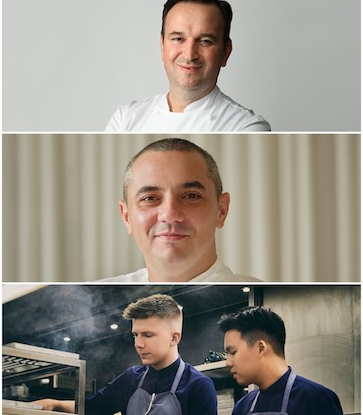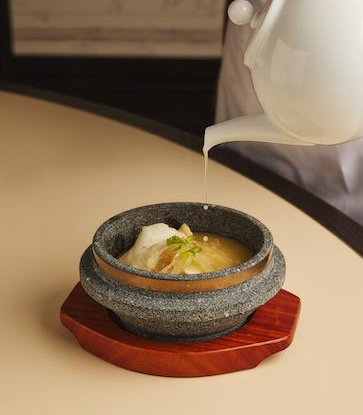"When you have to kill the animal open it up and cut it down, you realise you can do everything," says JP. "We never saw these animals as pets; they were food."
In fact, JP vividly remembers his first encounter with a sow. Then, he was just six years old, a curious young 'un peeking over the ledge of the sty. The mother pig, also curious to have a look at this daring child, jumped up on the ledge, causing a shocked JP to fall over backwards and hit his head on the ground. "I decided then that I would kill them all," jokes JP.
The picture becomes clearer as he speaks more about his childhood. He recalls his father going to the market and bringing back vegetables and livestock — a much cheaper option than pre-cut meats back in the early 1980s. Come winter, the town's butcher boy, Pepe, would come around. In exchange for glugs of wine, Pepe would show them the way to make pig's head terrine, sausages and ham. The blood, shares JP, was usually cooked for breakfast.
"The first thing I would do in the morning would be to chop potatoes and onions," shares JP. "I'll cook them until the pan is very hot, before putting the pig's blood in it. When you cook the blood like that, it looks like scrambled eggs. We have this with a lot of alcohol, like brandy and cognac. By 11am, usually everyone is drunk," he chuckles.
Not a taste for everyone
To be sure, it was JP, his sister, and father who always were partial to eating offal. His mother and brother, on the other hand, could never quite appreciate the taste of kidneys and calves' liver. It is no surprise then that JP specialises in nose-to-tail cuts today, while his brother works with lobsters and prawns.
"When I was young, we would cut up the pig and very little percentage of the whole hog was for meat like pork chops. We would usually end up curing 85 per cent of it," shares JP. "When a pig is over 200 kilos, there is so much meat to process. We'll make sausages, hams, and knuckles for the soup. The ears, we would give to Pepe."

While JP believes getting diners to accept nose-to-tail dining comes down partly to education, he notes that it is also about how you were brought up. "If you were from a well-off family, you would not go and get the cheap cuts," says JP. "But because our neighbours were farmers who breed quail and other animals, we had access to different types of produce and such off-cuts became natural," he continues.
Once a common dish in Europe back in the 60s and 70s, offal and off-cuts fell out of fashion from the 80s to the 90s when the economy picked up and people began making more money. During this time, demand for luxurious items such as lobster and good wine soared; off-cuts became a dish for those who could ill afford the same luxuries.
Though the concept of nose-to-tail dining became trendy again back in the early 1990s, with St John restaurant in London heading the wave of making brains and offal cool, JP notes that it never quite shook off the stigma of being a poor man's dish.
He recalls when he started work at Quo Vadis in London in May 2008, just a month before the big economic crisis hit. "We removed the white linen and went back to being more brasserie style, and changed the menu to a lot of nose to tail. We would cook things like faggot – an English dish made with the lining of pig stomach, liver and lungs — that were very hearty," says JP. "But again, we noticed our clientele was usually over 50 plus years old."
"It’s got the stigma of a poor man’s dish. Only the older generation will understand because they grew up with it. For younger people, there’s a stigma attached to it that it’s a poor man’s food."

One way to overcome these misconceptions is to try drawing local references for diners. Take being in Singapore. When JP first decided to open Dehesa, he expected more Singaporeans to take to the concept immediately. That did not happen.
"When I opened Dehesa, I just wanted to open a place where I could cook what I grew up with. I always thought a nose-to-tail concept would be more well-received in Singapore, since people eat pigs' intestines, but I was wrong," shares JP. Instead, diners would come in and dare each other to eat certain items on the menu, such as ducks' hearts, pig's head terrine and tripe. "It was really frustrating," says JP.
"The funny thing is, every customer who comes here tries to find similarities between the food they eat and local food," says JP. Pork knuckle, for instance, is often linked to bak kut teh, while secreto (a butcher's secret cut of meat) was said to resemble bak kwa.
His latest menu is now balanced with offerings from offal and off-cuts, to more recognised items like seafood, pork chops or ribs. Lamb brains and lungs are also on the charts. The one thing you'll never see on his menu, though — fillets or sirloin steaks.
"I don’t deny this part of the animal, and I'll say there’s really good steakhouses out there if you are looking for these cuts. But as a chef, I don't feel the urge to cook a fillet," says JP.
"Mainly because you don’t go to cooking school and learn nose-to-tail butchery. 98 per cent of restaurants will need a chef who can cook fillets of steak – no one is going to ask for a guy who can do something with brain.
You have to get the passion for this from somewhere else — upbringing."
























